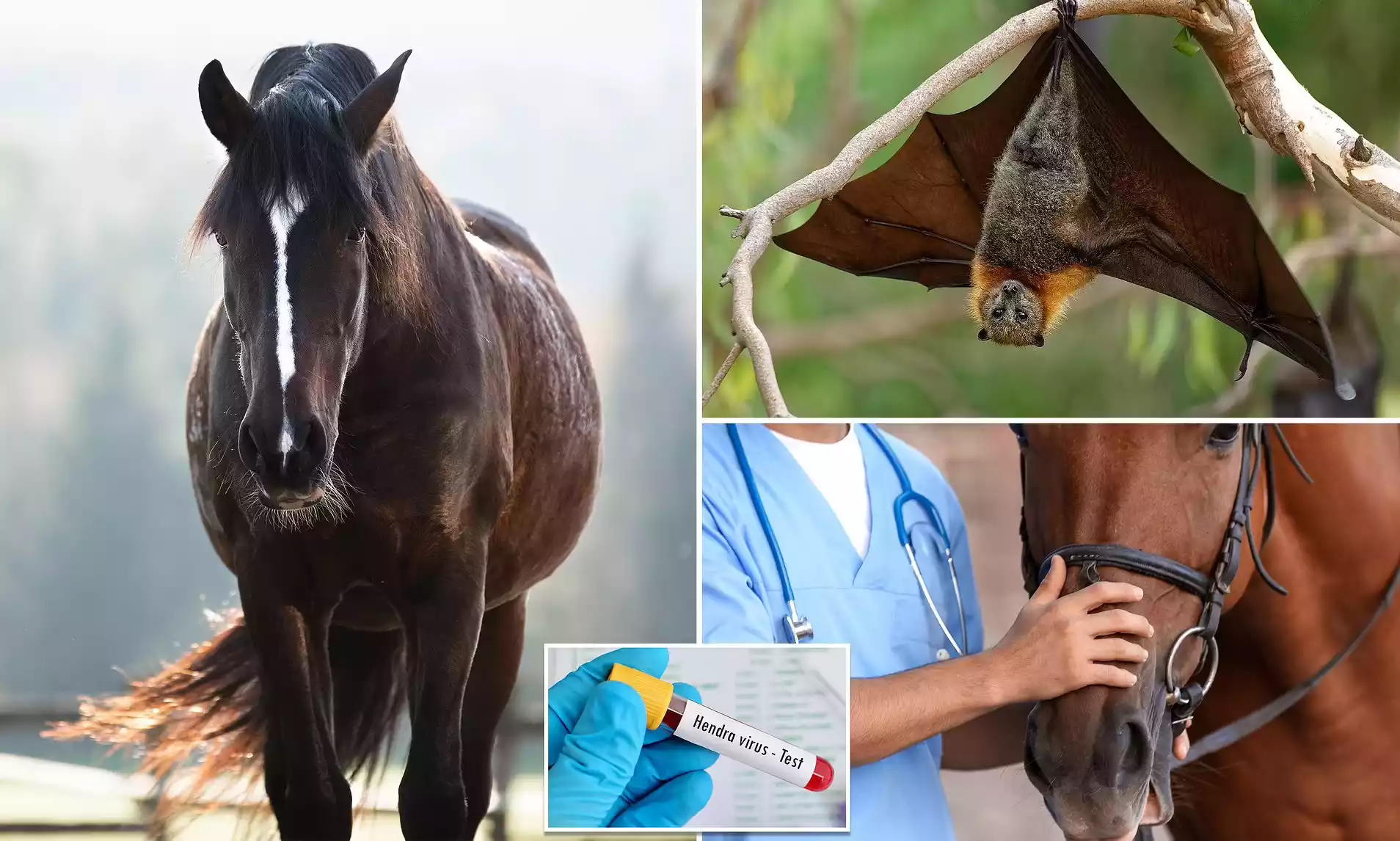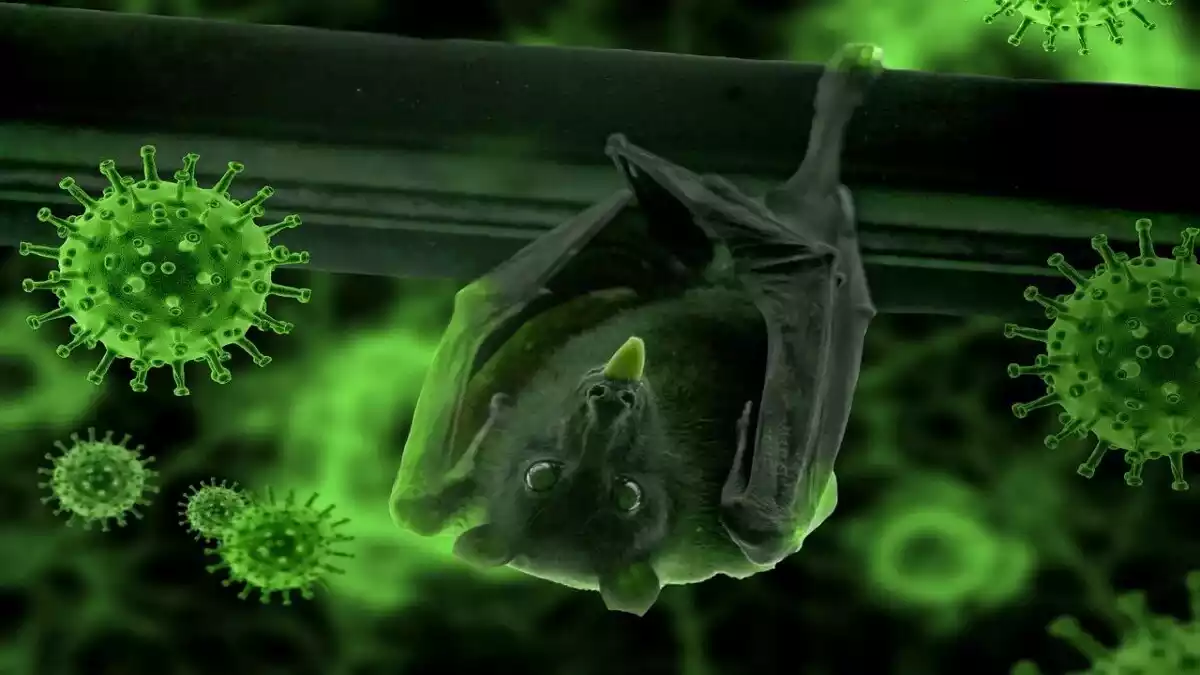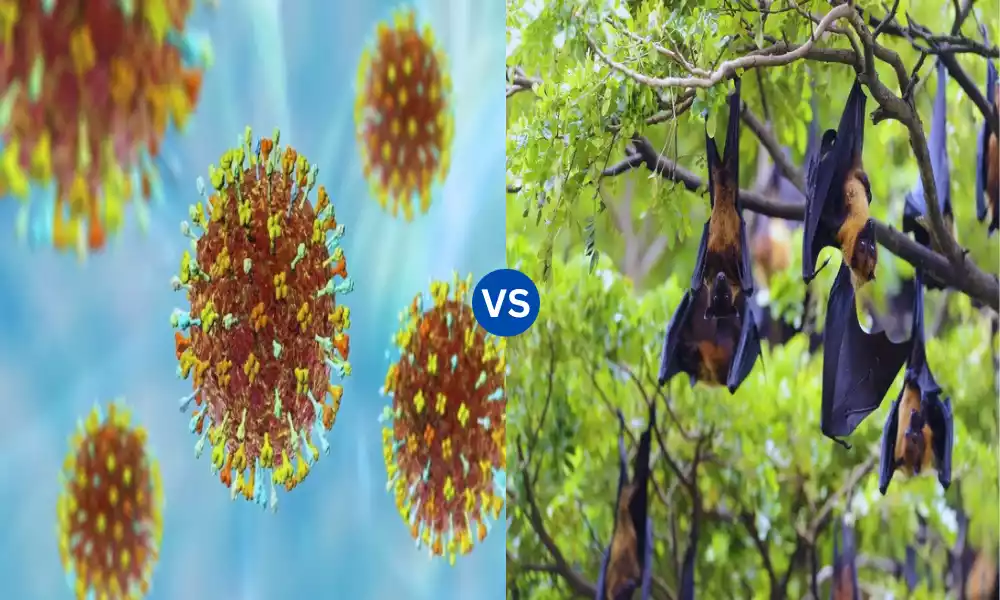Hendravirus and Nipahvirusare both members of the Henipavirus genus within the Paramyxoviridae family. These viruses are zoonotic pathogens, meaning they can be transmitted from animals to humans. Originating in fruit bats (flying foxes), these viruses can cause severe and often fatal respiratory and neurological disease in both animals and humans. Hendravirus was first identified in 1994 in Hendra, a suburb of Brisbane, Australia, after causing an outbreak in horses and humans.
Nipahvirus, on the other hand, was first recognized in 1998 in Malaysia, during an outbreak in pigs and people. Both viruses are of significant concern due to their high mortality rates and potential for human-to-human transmission.
Definition of Hendravirus
Hendravirus (HeV) is a paramyxovirus that belongs to the Henipavirus genus within the Paramyxoviridae family. It is a zoonotic virus, meaning it can be transmitted from animals, particularly fruit bats (flying foxes), to humans. The virus was first identified in 1994 following an outbreak in horses and humans in Hendra, a suburb of Brisbane, Australia. Infected individuals can manifest severe respiratory and neurological symptoms, and the virus has a notably high fatality rate. Because of its ability to infect a wide range of hosts and its potential for human-to-human transmission, Hendravirus is of significant public health concern.

Definition of Nipahvirus
Nipahvirus (NiV) is a member of the Henipavirus genus within the Paramyxoviridae family. It is a zoonotic virus, primarily transmitted to humans from animals, most notably fruit bats of the Pteropus genus, but also from infected pigs and other livestock. First identified during an outbreak in Malaysia in 1998, Nipahvirus causes severe respiratory and neurological disease in infected individuals, often with a high fatality rate.

The virus has the capability for human-to-human transmission, and occasional outbreaks have been reported in various parts of Southeast Asia. Due to its virulence, potential for transmission, and lack of a licensed vaccine or treatment for humans as of my last update in 2022, Nipahvirus remains a major public health concern.
History background
Both the Hendravirus and the Nipahvirus have intriguing and critical histories that have implications for public health. Here’s a brief history background of both:
Hendravirus (HeV):
- 1994: The virus was first identified in Hendra, a suburb of Brisbane, Australia, giving the virus its name. An outbreak resulted in the deaths of 13 horses and one human.
- Reservoir Identification: After its discovery, studies were undertaken to identify the natural reservoir of the virus. Fruit bats (flying foxes) of the Pteropus species native to Australia were identified as the natural hosts without showing any signs of illness.
- Subsequent Outbreaks: Since its first appearance, sporadic outbreaks have occurred in Australia, predominantly affecting horses. Some of these outbreaks led to human infections, usually among people in close contact with affected horses.
- Vaccine Development: A vaccine for horses against Hendravirus was developed to prevent its spread to humans.
Nipahvirus (NiV):
- 1998-1999: Nipahvirus was first recognized during an outbreak in Malaysia and Singapore among pig farmers, leading to over 100 human deaths. Pigs were the intermediate hosts in this outbreak.
- Reservoir Identification: Similar to Hendravirus, the natural reservoir for Nipahvirus was identified as fruit bats of the Pteropus genus. These bats can shed the virus in their excretions, which can then be transmitted to other animals or directly to humans.
- Subsequent Outbreaks: After the initial Malaysian outbreak, subsequent outbreaks occurred in other parts of Southeast Asia, including Bangladesh and India. Notably, in places like Bangladesh, human-to-human transmission and direct transmission from bats to humans have been observed.
- Transmission Routes: In some regions, consumption of raw date palm sap contaminated by bat excretions was identified as a significant transmission route to humans.
Both viruses have been classified as Biosafety Level-4 pathogens, the highest level, due to their high lethality and lack of effective treatments or vaccines for humans (as of 2022). Their histories underscore the challenges of managing emerging zoonotic diseases and the critical importance of understanding animal-human-environmental interfaces in disease transmission.
Comparison table of Hendravirus and Nipahvirus
Here’s a comparison table of Hendravirus and Nipahvirus:
| Feature | Hendravirus | Nipahvirus |
|---|---|---|
| Family | Paramyxoviridae | Paramyxoviridae |
| Genus | Henipavirus | Henipavirus |
| Primary Reservoir | Fruit bats (flying foxes) | Fruit bats (Pteropus genus) |
| First Identified | 1994 in Hendra, Australia | 1998 in Malaysia |
| Symptoms | Respiratory and neurological | Respiratory and neurological |
| Transmission | Bats to horses to humans, potential human-to-human | Bats to pigs/humans, human-to-human |
| Geographical Spread | Mainly Australia | Southeast Asia (e.g., Malaysia, Bangladesh, India) |
| Fatality Rate | High | High |
| Vaccines/Treatment | Vaccine for horses; no specific treatment for humans | No licensed vaccine or specific treatment for humans (as of 2022) |
This table provides a general comparison, there are many intricate details about each virus that may not be covered in a succinct format. Always refer to scientific literature and authoritative sources for a comprehensive understanding.
Hendravirus Symptoms
Hendravirus (HeV) infection in humans can lead to a range of clinical symptoms, with the disease often manifesting as severe respiratory or neurological illness. Here are the common symptoms associated with Hendravirus infection:
- Respiratory Symptoms:
- Acute respiratory distress
- Cough
- Difficulty breathing or shortness of breath
- Neurological Symptoms:
- Meningitis (inflammation of the membranes covering the brain and spinal cord)
- Encephalitis (inflammation of the brain)
- Seizures
- Headache
- Altered states of consciousness
- Drowsiness or confusion
- Other Symptoms:
- Fever
- Muscle aches or pains
- Fatigue
- Sore throat
The disease’s presentation can vary, and not all infected individuals will show all the symptoms mentioned above. The incubation period, or the time from exposure to the onset of symptoms, can vary but is typically within 5 to 21 days.
Given the severe nature of Hendravirus infection and its high mortality rate, it is crucial to seek medical attention promptly if someone is suspected of being infected, especially if they have been in contact with sick horses in areas where the virus is known to be present.
Nipahvirus Symptoms
Nipahvirus (NiV) infection can manifest as a range of clinical symptoms, from asymptomatic (showing no symptoms) to acute respiratory syndrome and fatal encephalitis (inflammation of the brain). Here are the common symptoms associated with Nipahvirus infection:
- Initial Symptoms:
- Fever
- Headache
- Drowsiness
- Disorientation or confusion
- Respiratory Symptoms:
- Cough
- Difficulty breathing or shortness of breath
- Acute respiratory distress
- Neurological Symptoms:
- Encephalitis
- Dizziness
- Altered states of consciousness
- Seizures
- Other Symptoms:
- Muscle aches or pains
- Fatigue
- Nausea and vomiting
- Sore throat
As the illness progresses, individuals may progress into a coma within 24-48 hours. The mortality rate for Nipahvirus is high, ranging from 40% to 75% depending on the outbreak and region.
The incubation period for Nipahvirus, or the time from exposure to the onset of symptoms, typically ranges from 4 to 14 days but can be as long as 45 days.
Diagnosis of Hendravirus and Nipahvirus
Hendra virus (HeV) and Nipah virus (NiV) are both members of the Henipavirus genus within the Paramyxoviridae family. Both viruses can cause severe and often fatal disease in humans and animals, especially horses for HeV and pigs for NiV. These viruses can spillover from their primary natural reservoir, fruit bats (flying foxes), to humans, directly or indirectly through intermediate hosts.
Diagnostic Methods:
- Real-time Polymerase Chain Reaction (RT-PCR):
- This is a common method used for the early detection of both Hendra and Nipah viruses in blood and cerebrospinal fluid (CSF).
- It’s highly specific and can detect the viral RNA, even when present in low quantities.
- Serological Testing:
- Enzyme-linked Immunosorbent Assay (ELISA): Detects antibodies to the viruses, indicating possible exposure. However, it may not be useful in the early stages of the disease as the immune system might not have produced significant antibodies yet.
- Neutralization Tests: These tests can also detect antibodies in the blood specific to the virus. It’s considered more specific than ELISA but is more labor-intensive.
- Immunohistochemistry (IHC):
- Useful in detecting viral antigens in tissue samples, especially post-mortem tissues. It can help confirm the diagnosis in deceased patients.
- Virus Isolation:
- The virus can be isolated from samples in cell culture. This is a definitive method for diagnosis but is more time-consuming than PCR and requires biosafety level-4 (BSL-4) containment due to the high pathogenicity of the virus.
- Clinical and Imaging Findings:
- While not diagnostic by themselves, symptoms such as fever, headache, drowsiness, and acute respiratory syndrome or encephalitis combined with imaging findings (like abnormalities in MRI or CT scans of the brain) can raise suspicion for Nipah virus infection, especially in endemic areas or after known exposures.
- Exposure History:
- Given that these viruses have specific geographical distributions and known reservoirs/hosts, a history of exposure (e.g., contact with sick horses in the case of Hendra or consumption of raw date palm sap or contact with sick pigs in the case of Nipah in endemic regions) can be an important clue.
Due to the high pathogenicity and the potential for these viruses to cause outbreaks, timely diagnosis and strict infection control practices are crucial. Laboratories that handle these viruses require specific biosafety precautions, and any samples suspected of containing the virus should be handled with extreme care.
Treatment approach for Hendravirus and Nipahvirus
Hendra virus and Nipah virus are both zoonotic viruses that can cause severe and often fatal infections in humans. There are currently no specific antiviral medications approved for the treatment of these viruses, so management primarily focuses on supportive care and preventive measures. Here’s an overview of the treatment approach for Hendra virus and Nipah virus infections:
Treatment Approach for Hendra Virus:
- Isolation and Infection Control: Suspected or confirmed cases of Hendra virus infection should be isolated to prevent further transmission. Strict infection control measures, including the use of personal protective equipment (PPE), should be observed by healthcare workers and caregivers.
- Supportive Care: There is no specific antiviral treatment for Hendra virus infection. Supportive care includes managing symptoms and providing treatments such as intravenous fluids, respiratory support, and medications to control fever and pain.
- Experimental Therapies: Experimental treatments and therapies, such as the use of monoclonal antibodies or antiviral drugs, have been explored in animal models, but their efficacy in humans remains unproven. These treatments may be considered on a case-by-case basis in consultation with infectious disease experts.
- Vaccination for Horses: Preventing Hendra virus infection in humans starts with preventing the infection in horses. A Hendra virus vaccine is available for horses in Australia, where the virus is endemic. Vaccinating horses can reduce the risk of human exposure to the virus.
- Post-Exposure Prophylaxis (PEP): In certain high-risk situations where individuals have had close contact with Hendra-infected horses or materials, PEP using human monoclonal antibodies has been considered. This is a preventive measure and not a treatment for established infection.
Treatment Approach for Nipah Virus:
- Isolation and Infection Control: Suspected or confirmed cases of Nipah virus infection should be isolated to prevent further transmission. Infection control measures, including strict use of PPE, are essential for healthcare workers and caregivers.
- Supportive Care: There is no specific antiviral treatment for Nipah virus infection. Supportive care includes addressing symptoms, maintaining hydration, providing respiratory support, and managing complications such as encephalitis.
- Experimental Therapies: Some experimental treatments, including antiviral drugs and monoclonal antibodies, have shown promise in preclinical studies or small-scale clinical trials. However, their efficacy and safety in humans are still being evaluated.
- Prevention: Preventing Nipah virus infection often involves measures such as avoiding contact with infected animals (especially bats and pigs), practicing good hygiene, and implementing outbreak control measures in affected areas.
- Vaccines: Several Nipah virus vaccine candidates are under development, but as of my last knowledge update in September 2021, none had received widespread approval or distribution for human use.
Hendra virus and Nipah virus infections are relatively rare but can be deadly. The primary focus is on prevention through vaccination for horses (Hendra virus) and avoiding exposure to infected animals (both viruses). In the event of an outbreak or suspected cases, strict infection control and supportive care measures are crucial for patient management. Experimental treatments may be considered in consultation with infectious disease experts, but their availability and effectiveness may vary. For the most up-to-date information and guidance, it’s advisable to consult with healthcare authorities and experts in the field.
Prevention and Control Measures
Prevention and control measures for Hendravirus and Nipahvirus largely focus on breaking the transmission chain from animals to humans and, where possible, from human to human. Here are some general and virus-specific measures:
Hendravirus (HeV):
- Vaccination: A vaccine for horses (Equivac® HeV) is available in Australia to reduce the risk of Hendravirus transmission from horses to humans.
- Personal Protective Equipment (PPE): Veterinarians and others working with potentially infected horses should use appropriate PPE.
- Awareness: Horse owners and handlers should be educated about the symptoms of Hendravirus in horses and the potential risks to humans.
- Isolate Sick Horses: Any horse showing symptoms should be isolated and tested.
- Avoid Contact with Flying Foxes: Since flying foxes are the reservoirs, reducing their attraction to populated areas (like securing fruit trees or covering fruit crops) can help reduce the risk.
Nipahvirus (NiV):
- Avoid Consuming Raw Date Palm Sap: In regions where transmission from bats to humans via raw date palm sap has been identified, people should avoid consuming it.
- Safe Food Practices: Thoroughly cook any food derived from animals. This is particularly relevant in regions where transmission from animals like pigs has been noted.
- Reduce Bat Access to Date Palm Sap: Using bamboo skirts or other physical barriers can reduce contamination by bat droppings or secretions.
- PPE for Healthcare Workers: Given the potential for human-to-human transmission, healthcare workers should use appropriate PPE when treating suspected or confirmed Nipah patients.
- Isolation: Patients with suspected or confirmed Nipahvirus infection should be isolated from other patients.
- Avoid Contact with Sick Animals: If an outbreak is suspected in animals, it’s crucial to avoid contact, especially without protection.
- Surveillance: Active surveillance is crucial, especially in regions prone to outbreaks, to detect and respond quickly to any new cases.
Both Viruses:
- Public Awareness: Raise public awareness about the diseases, their transmission routes, and prevention measures.
- Regular Handwashing: While this is a general preventive measure for many diseases, regular handwashing can reduce the risk of transmission.
- Avoid Disturbing Natural Habitats: Deforestation or intrusion into bat habitats can increase the chances of zoonotic spillover.
- Rapid Response: Rapid containment measures, including contact tracing and quarantine, are essential if an outbreak is suspected or confirmed.
Since both viruses have the potential to cause significant outbreaks with high mortality rates, timely and efficient prevention and control measures are critical to prevent their spread and protect public health.
Geographical Spread and Recent Outbreaks of Hendravirus and Nipahvirus
As of my last update in January 2022, here is a summary of the geographical spread and recent outbreaks associated with Hendravirus and Nipahvirus:
Hendravirus (HeV):
- Geographical Spread: The Hendravirus has been primarily confined to Australia. The natural reservoir, fruit bats or flying foxes of the Pteropus genus, are found in Australia.
- Recent Outbreaks: There have been sporadic outbreaks in Australia since the virus was first identified in 1994. Typically, these outbreaks have involved horses, with occasional transmission to humans who have close contact with the infected horses. As of 2022, there haven’t been large-scale outbreaks, but there were periodic reports of Hendra cases in horses.
Nipahvirus (NiV):
- Geographical Spread: After its discovery in Malaysia, the virus has been identified in several countries in Southeast Asia. Most notably, recurrent outbreaks have occurred in Bangladesh and India. The natural reservoir, fruit bats of the Pteropus genus, is widespread in the region.
- Recent Outbreaks:
- Malaysia and Singapore: The initial outbreak in 1998-1999 saw over 100 deaths, with the pig industry heavily affected. Since then, there haven’t been reports of outbreaks in Malaysia.
- Bangladesh: Since its first appearance in the early 2000s, almost annual outbreaks have been reported. Transmission in Bangladesh has been linked to consumption of raw date palm sap contaminated by bat secretions.
- India: Kerala state in India has witnessed a few outbreaks of Nipahvirus, notably in 2018 and 2019, with several deaths reported. The swift response by health officials and the government helped in containing these outbreaks.
The situation can evolve, and new outbreaks or reports might have occurred after 2022. For the most current information on these viruses and their outbreaks, the World Health Organization (WHO) and Centers for Disease Control and Prevention (CDC) websites are reliable and up-to-date sources.
Conclusion
Hendravirus and Nipahvirus, both members of the Henipavirus genus, are zoonotic pathogens that originate from fruit bats and have the potential to cause severe respiratory and neurological diseases in animals and humans. While Hendravirus has primarily affected Australia with horses as the main intermediary host, Nipahvirus has seen outbreaks in Southeast Asia, notably Malaysia, Bangladesh, and India, with transmission vectors ranging from pigs to direct bat-to-human contact.
The high mortality rates, potential for human-to-human transmission, and lack of specific treatments for humans have made these viruses significant public health concerns. Prevention and rapid response remain crucial in managing their potential outbreaks.



